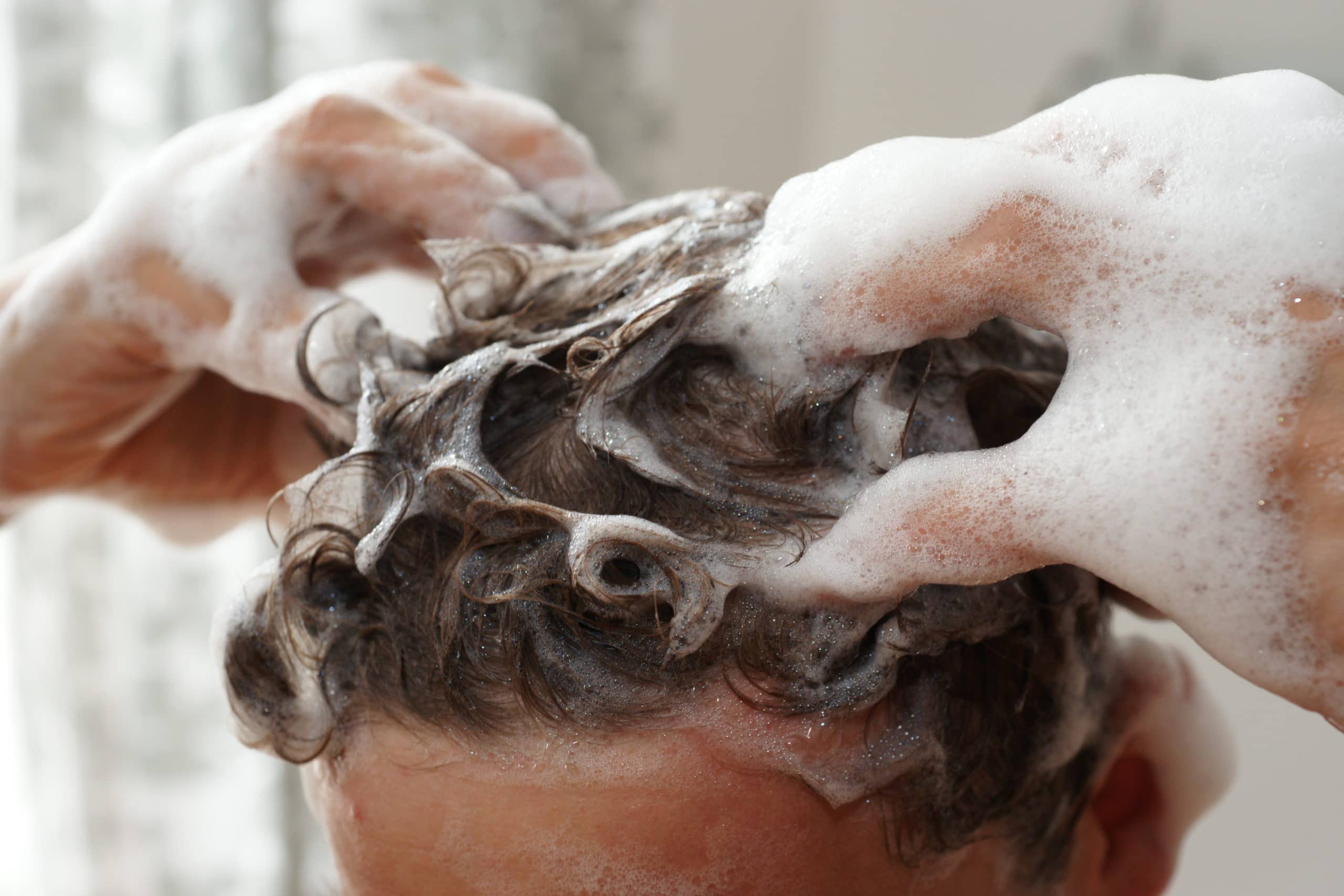Washing your hair after your transplant is an important step in your recovery. It is important to wash so your scalp heals well but also because it allows you to return to work and social activities quicker.
Whether you’ve had a follicular unit transplant (FUT) or follicular unit excision (FUE), looking after hair properly post-transplant is critical to allowing the newly grafted hairs to thrive. In this article we will help explain how you can wash you hair after your surgery.
In our clinic, we aim for our patients to be scab free by Day 7 post surgery. We provide clear, detailed post-surgery hair wash protocols to help you achieve this. Below you will see a patient pictured on the day of surgery (D1), the day after surgery (D2) and on Day 7 (D7) after surgery. He is scab free after 7 days.

In this article, we’ll guide you through which techniques you should be using, outlining the essential steps to wash your hair in a way that not only promotes healing but also encourages hair growth.
Why does proper hair washing matter?
After having a hair transplant, it’s important to be mindful of the immediate and short-term effects of the procedure.
Directly after the transplant, for example, your scalp will often be particularly sensitive to being touched. Therefore, to avoid damaging the hair roots, you should avoid touching or wetting this area for at least three days.
Learning how to wash your hair properly can be vital to preventing damage and ensuring your transplant is successful. Not only that, it also ensures that the transplanted area is kept clean, reducing the risk of any unexpected complications like infection3. We often find patients who aren’t washing or delay their first wash can get an itchy scalp which predisposes them to infections and discomfort.

It is important to wash when advised by your Surgeon or clinic. Understanding which types of products you should be using or avoiding can also make a big difference to the overall health and quality of your transplanted hair grafts. We tend to recommend a pH balanced, dermatologically tested shampoo for your aftercare washes.

When can you wash your hair after a hair transplant?
Timing the first post-transplant hair wash is a crucial step in the recovery process.
While many clinics may state different suggested timings, here at The Treatment Rooms London, we recommend that your first hair wash with your fingers/ palms should be on day 5 following your surgery (surgery day being day 1). You have the option of soaking your transplant with a foamy mix the day before and our clinic will give its patients clear instructions on how to do this safely.
Washing at this time should give enough time for the transplanted hair roots to be suitably anchored in place before shampooing. If you wanted to understand when your grafts become secure in your scalp you can read our dedicated article on the topic here: when do your grafts become secure after a hair transplant?
However, since everyone’s circumstances are different, your surgeon will be able to advise you on when you should plan for your initial post-transplant hair wash.
Preparing for the first hair wash
To prepare for your first hair wash, there are a few items and supplies we would recommend having easily available and within reach. These include:
- Low-pressure water source – being gentle is crucial during your first post-transplant hair wash so make sure to have a low-pressure shower head setting available, or use cups to gently pour water over your head.
- A gentle shampoo – this can be provided as part of your aftercare and recovery package along with detailed instructions from your surgeon on how to use it effectively.
How to wash your hair after a hair transplant
When it comes to washing your hair for the first time after your hair transplant, there are certain steps and techniques you will need to follow.
While your surgeon will be able to provide you with tailored advice, the general process will typically involve the following steps.
Step 1: Gently wet your hair
Don’t put your head directly under strong shower jets, as this could dislodge the hair grafts. Instead, use a low-pressure water source or cups to gently wet your hair.
Step 2: Apply the recommended shampoo (or saline solution)
Using the palms of your hands, fingertips or a combination of both, gently massage or tap-in your surgeon-recommended shampoo into your scalp.
Step 3: Gently rinse the scalp
Once your scalp has been suitably covered with shampoo, let it soak in for 5 minutes and then use the same low-pressure source of lukewarm water or cups to gently rinse it away.
Step 4: Allow time to dry
After the shampoo has been sufficiently rinsed off, let your hair naturally air dry.
How often should you wash your hair after a hair transplant?
During the first two weeks after your hair transplant procedure, it is essential to wash your hair on a daily basis and ideally twice a day. This is to help remove dried blood and scabs while keeping the transplanted area as clean and healthy as possible.
After these initial two weeks are over, all of your scabs should have disappeared and your transplanted hair grafts should have anchored themselves a lot more strongly into your scalp. At this point, you can then go back to your regular hair-washing routine using standard products.
However, we would recommend following the advice in your aftercare package. This will provide you with recommendations on the best hair care practices to use to ensure your hair transplant remains successful over the long term, including specialist shampoos that can reduce issues like scalp itchiness5.
Should you delay washing your hair after a hair transplant?
We don’t recommend delaying your hair washing after surgery. It is important to follow the aftercare advice closely to ensure safe, predictable healing.
Risks of washing your hair transplant
The main 2 risks associated with washing your hair after surgery are:
- Washing too early before the grafts have time to secure into the scalp
- Delaying your first wash, risking infection, poor wound healing and prolonged redness
Additional hair transplant aftercare tips
In addition to washing your hair correctly, there are several other things to consider during your aftercare to maximise your hair transplant’s success. These include:
- Follow the surgeon’s aftercare instructions – your surgeon will be able to provide tailored advice and recommendations based on factors like your age and medical history. Sticking to their advice and guidance is crucial for achieving a successful outcome.
- Take prescribed medications – certain medications, like finasteride, minoxidil or a combination of both, can help reduce hair loss and support hair growth6. Therefore, it’s vital to follow any medication regimen your surgeon prescribes.
- Avoid strenuous activities – you will need to refrain from working out for at least 2 weeks after your hair transplant to give your scalp enough time to recover and allow the grafts to strengthen.
- Allow time for recovery – after your procedure, it’s important to avoid anything that could increase your risk of infection, such as commuting on public transport or allowing home pets to come close to the area of surgery. As such, give yourself enough recovery time by either working from home or taking one or two weeks off work.
- Protect your head from the sun – when going out and about, protecting your head from sun exposure is crucial to avoiding UV damage7, safeguarding your hair grafts and promoting the healing process7.
Get in touch for further advice
Here at The Treatment Rooms London, we specialise in helping patients with a wide variety of hair loss concerns, including post-transplant hair washing.
Our dedicated team can provide you with personalised advice to ensure your post-transplant hair care journey gets you back to looking and feeling your best. We are able to treat men, female and transgender patients with their hair loss.
Simply book a consultation with us to get started.
References
- Liu, F., Miao, Y., Xingdong, L., et al. (2018) The relationship between self-esteem and hair transplantation satisfaction in male androgenetic alopecia patients. Journal of Cosmetic Dermatology. 18(5): 1441 – 1447. Available at: https://onlinelibrary.wiley.com/doi/full/10.1111/jocd.12839
- Garg, A. & Garg, S. (2021) Complications of Hair Transplant Procedures—Causes and Management. Indian J Plast Surg. 54(4): 477 – 482. Available at: https://www.ncbi.nlm.nih.gov/pmc/articles/PMC8719980/
- Kerure, A. & Patwardhan, N. (2018) Complications in Hair Transplantation. J Cutan Aesthet Surg. 11(4): 182 – 189. Available at: https://www.ncbi.nlm.nih.gov/pmc/articles/PMC6371733/
- Küçüktaş M (2017) Complications of Hair Transplantation. Hair and Scalp Disorders. InTech. Available at: http://dx.doi.org/10.5772/66838
- Schweiger, D., Schoelermann, A., Filbry, A., et al. (2015) Highly efficient and compatible shampoo for use after hair transplant. Clin Cosmet Investig Dermatol. 8: 355 – 360. Available at: https://pubmed.ncbi.nlm.nih.gov/26229498/
- Chen, L., Zhang, J., Wang, L., et al. (2020) The Efficacy and Safety of Finasteride Combined with Topical Minoxidil for Androgenetic Alopecia: A Systematic Review and Meta-analysis. Aesthet Plast Surg. 44(3): 962 – 970. Available at: https://pubmed.ncbi.nlm.nih.gov/32166351/
- Sebetić, K., Masnec, I., Cavka, V. (2008) UV damage of the hair. Coll Antropol. 32(2): 163 – 165. Available at: https://pubmed.ncbi.nlm.nih.gov/19138021/
Share:
Authored by
Reviewed by
Book a Consultation
Related Blogs
Ronnie Vint – Love Island Hair Transplant: Before, After, And His Hairline
April 14, 2025
Ronnie Vint, a former footballer and current TV personality, appeared on the 2024 season of “Love Island”…
Prince Harry Hair Loss: Speculations, Treatments, and Possible Transplant Options
April 13, 2025
Prince Harry, the Duke of Sussex and beloved royal-turned-global humanitarian, has sparked global curiosity over his ever-evolving…
Gordon Ramsay Hair Transplant: Before, After, and His New Hairline
April 12, 2025
Gordon Ramsay, the fiery Michelin-starred chef, restaurateur and TV personality, has swapped his receding temples for a…
Elon Musk Hair Transplant: Before, After and His New Hairline
April 11, 2025
Elon Musk, the billionaire behind Tesla and SpaceX, is a well known figure for his innovations and…
Xherdan Shaqiri Hair Transplant: Before, After, and His New Hairline
April 10, 2025
Xherdan Shaqiri is a Swiss international football star best known for his stints at Bayern Munich, Stoke…
Ariana Grande Hair Loss: Prevention, Styling Secrets, and Hypothetical Transplant Solutions
April 10, 2025
Ariana Grande, the global pop sensation renowned for her signature high ponytail and bold hairstyles, has openly…
Daniel Craig Hair Transplant: Before, After and His Hairline
April 10, 2025
Daniel Craig, the world-famous English actor who gained international fame as the fast-paced, debonair James Bond, has…
Rob Brydon Hair Transplant: Before, After, and His New Hairline
April 8, 2025
Rob Brydon, the beloved Welsh comedian and Gavin & Stacey star, has traded his receding hairline for…
Has Perez Hilton had a hair transplant? All You Need to Know
April 2, 2025
Perez Hilton is a familiar face in the media. He is known for his work as a…











